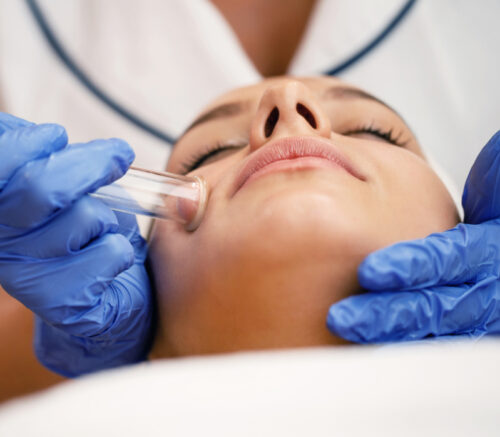FACIAL TREATMENT
For Skin Care & Health
Skincare has become a hot topic, attracting interest and innovation from both science and the beauty industry. Increasingly, both men and women are becoming conscious about skin care. While advanced formulas aim for flawless skin, many people still rely on time-honored remedies, like Facial Cupping.
The cosmetic industry and the field of dermatology both work towards the same fundamental goals: clear skin, reducing uneven skin tone, minimizing pimples, acne, fine lines, and wrinkles for a younger, fresher, and more attractive appearance.
Hijama Therapy, also known as 'Facial Cupping', plays a vital role in addressing various skin issues. Initially, its use was controversial among experts, but now it is widely accepted and used to treat conditions such as:
◆ Acne-prone skin
◆ Dark circle
◆ Puffiness
◆ Scars and marks on face and other visible areas
◆ Wrinkles and fine lines
◆ Uneven skin tone or pigmentation
◆ Tightening skin and improving the tone of chin and neck
◆ Improving jawline
HERE'S HOW THE PROCESS WORKS:
First, a skin expert assesses your skin to determine the appropriate cup size, taking into account your specific concerns. Smaller cups are typically used for the face, chin, and jawline. To reduce the risk of bruises or other side effects, a mild massage is given before cupping. This prepares the skin for Hijama and enhances lymphatic drainage.
Our therapists apply special oils and lotions to the client's face and neck, followed by a relaxing 10-15 minute massage. They also explain the procedure to the client. On the face, wet or fire cupping is avoided. Instead of static cupping, therapists prefer moving the cups. This stimulates the skin, draws blood to the surface of the face, and helps to flush out toxins through the lymphatic system.
BENEFITS OF FACIAL CUPPING
FACIAL CUPPING HAS NUMEROUS BENEFITS. THE PRACTICE CAN:
◆ Increase oxygen-rich blood circulation: This helps rejuvenate the skin, making it healthier and more vibrant.
◆ Strengthen skin and connective tissues: This promotes overall skin health and resilience.
◆ Stimulate cells responsible for collagen production: Collagen keeps your skin looking young and firm.
◆ Relax muscle tension: This results in a smoother and more relaxed appearance of the face.
AS A RESULT OF THESE BENEFITS, FACIAL CUPPING IS SAID TO:
◆ Brighten skin: Your skin can look more radiant and glowing.◆ Minimize the appearance of scars, fine lines, and wrinkles: It can help reduce visible signs of ageing.
◆ Tone the chin, jawline, neck, and décolletage: This helps in achieving a more defined and youthful appearance.
◆ Decrease puffiness: It can help reduce inflammation and swelling.
◆ Regulate oil production: This can lead to fewer acne breakouts.
◆ Improve nutrient delivery and product absorption: This means your skin can better absorb skincare products, making them more effective.
ARE YOU CONCERNED ABOUT FACIAL CUPPING? IT'S NORMAL TO HAVE QUESTIONS, LET’S ADDRESS THESE QUERIES:
Is it painful? No, Facial Cupping isn't painful. You might feel a small pull or suction on the skin, but the therapist usually begins with milder suction, especially in the first few sessions, depending on your skin's sensitivity. Will my face swell up? In rare instances, particularly in those with sensitive or acne-prone skin, there might be mild swelling or a few breakouts in the first few hours. However, with proper hydration and by avoiding caffeine, the inflammation subsides, and you start seeing results.
Will it leave bruises or scars? Unlike Hijama on other parts of the body, Hijama on the face involves moving the cups around, reducing the risk of marking. However, if the cups are left in one spot for too long, discolouration could occur. Will there be bleeding? No, wet cupping is never performed on the face, and facial cups, which are softer than those used for other body parts, are used.
Does it work? Yes, many people, both young and middle-aged, have embraced cupping as an alternative skincare routine and reported impressive results. But for the best outcomes, it's advisable to have it done by a trained professional. As a beginner, consider starting with a session per week for the first ten weeks.

